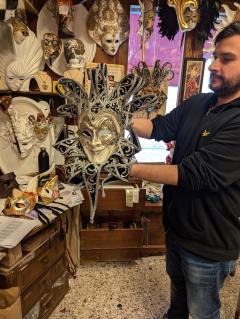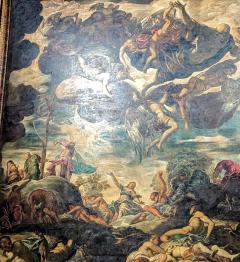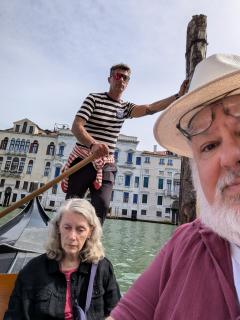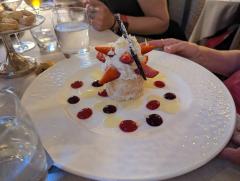 On Saturday the 25th we explored San Polo in the morning, in the afternoon we saw our third opera of the trip, Mozart's Don Giovanni at the Teatro La Fenice, and in the evening we revisited San Marco. In town today were two cruise ships, the MSC Lirica and the Costa Deliziosa, adding over 5,000 new tourists to the streets and shops of Venice.
On Saturday the 25th we explored San Polo in the morning, in the afternoon we saw our third opera of the trip, Mozart's Don Giovanni at the Teatro La Fenice, and in the evening we revisited San Marco. In town today were two cruise ships, the MSC Lirica and the Costa Deliziosa, adding over 5,000 new tourists to the streets and shops of Venice.
This was our last full day in Venice. Starting tomorrow we would be exploring the east and southern coasts in a rental car and spending no more than one night in any hotel for the next eight nights, so we had our laundry done at the hotel, to be ready that evening. Looking back, that was too long a period to have to pack for, and our bags were heavy. We had had two nights in Prague and three in Vienna, but those were too early to get laundry done until the last day in Vienna, and then the local laundry was closed for a holiday. Next time I will make sure we need pack for no longer than 5-6 days.
 We walked over the big white Ponte degli Scalzi near our hotel and made our way through the residential areas of Santa Croce and San Polo to the huge church of Santa Maria Gloriosa dei Frari and the nearby Scuola Grande di San Rocco.
We walked over the big white Ponte degli Scalzi near our hotel and made our way through the residential areas of Santa Croce and San Polo to the huge church of Santa Maria Gloriosa dei Frari and the nearby Scuola Grande di San Rocco.
Two years earlier, we had visited Santa Maria dei Frari on Brigitte's suggestion; she wanted to see a famous Titian painting there. I remember standing beside her looking at the painting, and realizing that she was seeing more in that canvas than I was. I vowed then to learn more about the art of Venice, to better appreciate it on our return. Along the way I became a fan of one in particular, Jacopo Robusti, called Tintoretto. Tintoretto was known in his day for his ability to finish large and complex works quickly and under budget. Today he is remembered for his pioneering dramatic compositions and action. Remember that yesterday morning we had seen his early work at Madonna dell'Orto before going to Burano; today I got to see his greatest achievement.
 Beside the church is the Scuola Grande di San Rocco. During the Renaissance, there were dozens of religious fraternal organizations in Venice set up by the leading men of the various trades. The men who set up the San Rocco organization had great wealth and great luck. They built the Scuola (school) as a meeting place, and they invited the top painters of Venice to submit sketches of how they would decorate the place. The ambitious young Tintoretto, having been thrown out of Titian's studio as talented but unteachable, presented this completed painting as a free contribution to the new Scuola. This had the desired effect; he was awarded the contract that lasted the next 20 years, during which time he completed 35 paintings that made him a star. Here's a detail from one of my favorites, the Miracle of the Brazen Serpent, from the Bible, Numbers 21:4-9.
Beside the church is the Scuola Grande di San Rocco. During the Renaissance, there were dozens of religious fraternal organizations in Venice set up by the leading men of the various trades. The men who set up the San Rocco organization had great wealth and great luck. They built the Scuola (school) as a meeting place, and they invited the top painters of Venice to submit sketches of how they would decorate the place. The ambitious young Tintoretto, having been thrown out of Titian's studio as talented but unteachable, presented this completed painting as a free contribution to the new Scuola. This had the desired effect; he was awarded the contract that lasted the next 20 years, during which time he completed 35 paintings that made him a star. Here's a detail from one of my favorites, the Miracle of the Brazen Serpent, from the Bible, Numbers 21:4-9.
 The Scuola is visited by many people, and it is well organized. Many of the most interesting paintings are on the ceilings of the rooms. Rather than have people craning their necks and bumping into each other all day, they provide framed mirrors with chains that you can use to hang a mirror around your neck and thus see the ceiling works in much greater comfort. On the other hand, now you have people staring at their mirrors and bumping into each other with those sharp corners!
The Scuola is visited by many people, and it is well organized. Many of the most interesting paintings are on the ceilings of the rooms. Rather than have people craning their necks and bumping into each other all day, they provide framed mirrors with chains that you can use to hang a mirror around your neck and thus see the ceiling works in much greater comfort. On the other hand, now you have people staring at their mirrors and bumping into each other with those sharp corners!
The gift shop has a good guide book with all of the paintings, their locations within the Scuola, and explanations of some of the iconography that was easily meaningful to the religiously minded Catholic people of 16th century Venice, but less so for the thousands of tourists from all faiths and cultures who see them today.
 As we were leaving the Scuola it had started to rain. Lorna and Melissa stopped at a sidewalk vendor with umbrellas and ponchos, and I got this great photo. Then we went to our favorite Venetian mask maker, the Atelier Marega. I wanted to get a special Venetian gift for my sister, who was celebrating a big birthday. Venetian masks are an important part of the culture, used during the masked balls of the famous Carnevale in late winter every year. Some are for wearing, but many very ornate masks are produced just for display. I selected the black, silver, and gold display mask that you see at the top of this page and had it shipped to her in time for her birthday.
As we were leaving the Scuola it had started to rain. Lorna and Melissa stopped at a sidewalk vendor with umbrellas and ponchos, and I got this great photo. Then we went to our favorite Venetian mask maker, the Atelier Marega. I wanted to get a special Venetian gift for my sister, who was celebrating a big birthday. Venetian masks are an important part of the culture, used during the masked balls of the famous Carnevale in late winter every year. Some are for wearing, but many very ornate masks are produced just for display. I selected the black, silver, and gold display mask that you see at the top of this page and had it shipped to her in time for her birthday.
 The opera was to start at 3:30 and it was already 1:00 pm so we had to get some lunch. This we did at Fanal della Codega, on a canal at the end of a narrow street from the mask shop. It was excellent. I asked if they could make for me a custom shrimp sampler with three types of shrimp that we don't get in restaurants in Plymouth: scampi, mazzancolle, and gamberi rossi crudi, shown here. Between the five of us we also got baked rombo (turbot, a sort of large flounder) filleted tableside, pasta with fresh porcini mushrooms, seppie con polenta (cuttlefish), polpo con patate (octopus) , espresso, Aperol spritz, and a bottle of Muller Thurgau, a crisp white wine from the Italian Alps.
The opera was to start at 3:30 and it was already 1:00 pm so we had to get some lunch. This we did at Fanal della Codega, on a canal at the end of a narrow street from the mask shop. It was excellent. I asked if they could make for me a custom shrimp sampler with three types of shrimp that we don't get in restaurants in Plymouth: scampi, mazzancolle, and gamberi rossi crudi, shown here. Between the five of us we also got baked rombo (turbot, a sort of large flounder) filleted tableside, pasta with fresh porcini mushrooms, seppie con polenta (cuttlefish), polpo con patate (octopus) , espresso, Aperol spritz, and a bottle of Muller Thurgau, a crisp white wine from the Italian Alps.
 It was an excellent lunch, but time-consuming and we had to make haste to the Teatro la Fenice in San Marco on the other side of the Grand Canal. The Rialto was far off to our left and the Accademmia bridge far off to our right. We could wait for a Vaporetto but it would drop us at an inconvenient location. The only option left was to board a long skinny traghetto to make the quick trip across the busy canal. Like the gondolas, the traghetti are not motorized, relying solely upon the strong muscles and quick instincts of highly experienced gondoliers.
It was an excellent lunch, but time-consuming and we had to make haste to the Teatro la Fenice in San Marco on the other side of the Grand Canal. The Rialto was far off to our left and the Accademmia bridge far off to our right. We could wait for a Vaporetto but it would drop us at an inconvenient location. The only option left was to board a long skinny traghetto to make the quick trip across the busy canal. Like the gondolas, the traghetti are not motorized, relying solely upon the strong muscles and quick instincts of highly experienced gondoliers.
Lorna was none too pleased with this option, but if you are not seated at the opera when the curtain goes up, you must wait outside until the intermission, so she joined us and focused entirely on surviving the trip. It was like going four-wheeling over the dunes as we crested the wakes of the vaporetti and the water taxis and working boats, but we arrived safely and in time.
 The Teatro la Fenice is an old opera house. opened in 1792 after its predecessor burned. La Fenice is "the Phoenix", because it rose from the ashes. It's a comparatively small hall, quite beautiful inside but with average acoustics. We had good seats so we could see and hear everything easily, and I was able to watch the orchestra, too, something that I always enjoy.
The Teatro la Fenice is an old opera house. opened in 1792 after its predecessor burned. La Fenice is "the Phoenix", because it rose from the ashes. It's a comparatively small hall, quite beautiful inside but with average acoustics. We had good seats so we could see and hear everything easily, and I was able to watch the orchestra, too, something that I always enjoy.
The production was uneven: the costumes were very good and the voices and acting were excellent. Don Giovanni was particularly charismatic and very good at showing a refined and calculating wickedness that was perfect for the role. The orchestra was excellent, but the sets were confusing and they spun about like the floor of a ballroom during a grand waltz. Worst of all was that they used a variant happier ending that has been used before in other productions around the world, but it is completely different from what Mozart wrote, and in my opinion it diminishes the whole effect of the divine retribution of the evil title character.
 The opera ended around 7pm. We had a leisurely debriefing and farewell with Owen and Brigitte over a good dinner at Antico Martini, in the piazza just outside of the Teatro: a cheese plate, a bottle of good Amarone, vegetarian Fiori di Zucca (stuffed pumpkin blossoms), granceola with no shell, grilled salmon, and two salads. For dessert we had frozen souffle, meringue, and gelato desserts, and a very nice Maculan Torcolato passito dessert wine from Vicenza, similar to the delicious Vin Santo available throughout Italy. I was concerned that a restaurant with such a location might compromise on quality or service, but everything was very good.
The opera ended around 7pm. We had a leisurely debriefing and farewell with Owen and Brigitte over a good dinner at Antico Martini, in the piazza just outside of the Teatro: a cheese plate, a bottle of good Amarone, vegetarian Fiori di Zucca (stuffed pumpkin blossoms), granceola with no shell, grilled salmon, and two salads. For dessert we had frozen souffle, meringue, and gelato desserts, and a very nice Maculan Torcolato passito dessert wine from Vicenza, similar to the delicious Vin Santo available throughout Italy. I was concerned that a restaurant with such a location might compromise on quality or service, but everything was very good.
 Then we made our farewells. Owen and Brigitte were heading back to Nuremberg in the morning, while we were just about to start the second half of our grand adventure. The cruise ship passengers were gone or leaving and we walked slowly through San Marco, talking about the opera and about the fun we'd had with our friends, as we made our way through the winding streets to the Rialto and took a water taxi back to the hotel.
Then we made our farewells. Owen and Brigitte were heading back to Nuremberg in the morning, while we were just about to start the second half of our grand adventure. The cruise ship passengers were gone or leaving and we walked slowly through San Marco, talking about the opera and about the fun we'd had with our friends, as we made our way through the winding streets to the Rialto and took a water taxi back to the hotel.
